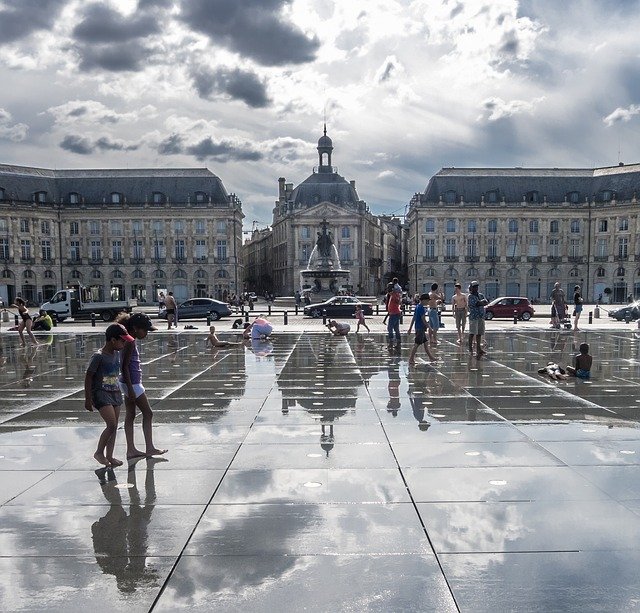Public realm
The term ‘public realm’ is often used loosely, sometimes interchangeably with ‘public domain’, to refer to external urban spaces that are publicly accessible.
According to English Heritage, the public realm ‘…relates to all parts of the built environment where the public has free access. It encompasses: all streets, squares, and other rights of way, whether predominantly in residential, commercial or civic uses...’
DETR defines the public realm as 'Outdoor areas in towns and cities which are accessible to the public' ref The HS2 London-West Midlands Environmental Statement, Glossary of terms and list of abbreviations, 2013.
Bradford City Centre Design Guide, Supplementary Planning Document, published in 2006, defines public realm as: 'The public spaces of an urban area. This includes streets, squares and parks where people are free to walk. It does not include private gardens or courtyards or shopping malls.'
Urban Design Guidelines for Victoria, published by The State of Victoria Department of Environment, Land, Water and Planning in 2017, suggest that: ‘…public realm comprises spaces and places that are open and freely accessible to everyone, regardless of their economic or social conditions. These spaces can include streets, laneways and roads, parks, public plazas, waterways and foreshores.’
The London Plan, published by the Mayor of London in March 2016, defines the public realm as: ‘…the space between and within buildings that is publicly accessible, including streets, squares, forecourts, parks and open spaces.’
High Speed Rail (Crewe – Manchester) Environmental Statement, Glossary, abbreviations and references, published by the Department for Transport in 2022, defines the public realm as: ‘Outdoor areas, other than highways, accessible to the public in towns and cities.’
The term can also be used as a means of describing the physical manifestation of community and of human interaction outside the private home. The ‘everyday spaces’ that are used by people to socialise, play, work, shop, traverse and use for activities such as exercise, enable social processes among residents and citizens.
Whether it is a road between rows of housing, or an urban park, the qualities of the public realm are integral to its use, and this consideration shapes the practice of placemaking.
Placemaking is a term used to describe the process by which an area in the public realm is given a unique and attractive character. For more information see: Placemaking.
NB: Cousseran says that ‘public space is a particular kind of social space created specifically for the bringing together of people, and where locals and strangers, the familiar and the unusual, can mingle freely.’ (Ref. Post-Modern Movement: The Inscribed City, in Urban Design Futures, Alain Cousseran ed Moor, Rowland, Routledge, 2006)
Public domain can also refer to knowledge that is: 'Generally known either by the public at large, or a certain section of it; readily obtainable outside of the organisation.' Ref https://www.cips.org/knowledge/glossary-of-terms/
[edit] Related articles on Designing Buildings
IHBC NewsBlog
IHBC Context 183 Wellbeing and Heritage published
The issue explores issues at the intersection of heritage and wellbeing.
SAVE celebrates 50 years of campaigning 1975-2025
SAVE Britain’s Heritage has announced events across the country to celebrate bringing new life to remarkable buildings.
IHBC Annual School 2025 - Shrewsbury 12-14 June
Themed Heritage in Context – Value: Plan: Change, join in-person or online.
200th Anniversary Celebration of the Modern Railway Planned
The Stockton & Darlington Railway opened on September 27, 1825.
Competence Framework Launched for Sustainability in the Built Environment
The Construction Industry Council (CIC) and the Edge have jointly published the framework.
Historic England Launches Wellbeing Strategy for Heritage
Whether through visiting, volunteering, learning or creative practice, engaging with heritage can strengthen confidence, resilience, hope and social connections.
National Trust for Canada’s Review of 2024
Great Saves & Worst Losses Highlighted
IHBC's SelfStarter Website Undergoes Refresh
New updates and resources for emerging conservation professionals.
‘Behind the Scenes’ podcast on St. Pauls Cathedral Published
Experience the inside track on one of the world’s best known places of worship and visitor attractions.
National Audit Office (NAO) says Government building maintenance backlog is at least £49 billion
The public spending watchdog will need to consider the best way to manage its assets to bring property condition to a satisfactory level.

















Comments
[edit] To make a comment about this article, click 'Add a comment' above. Separate your comments from any existing comments by inserting a horizontal line.